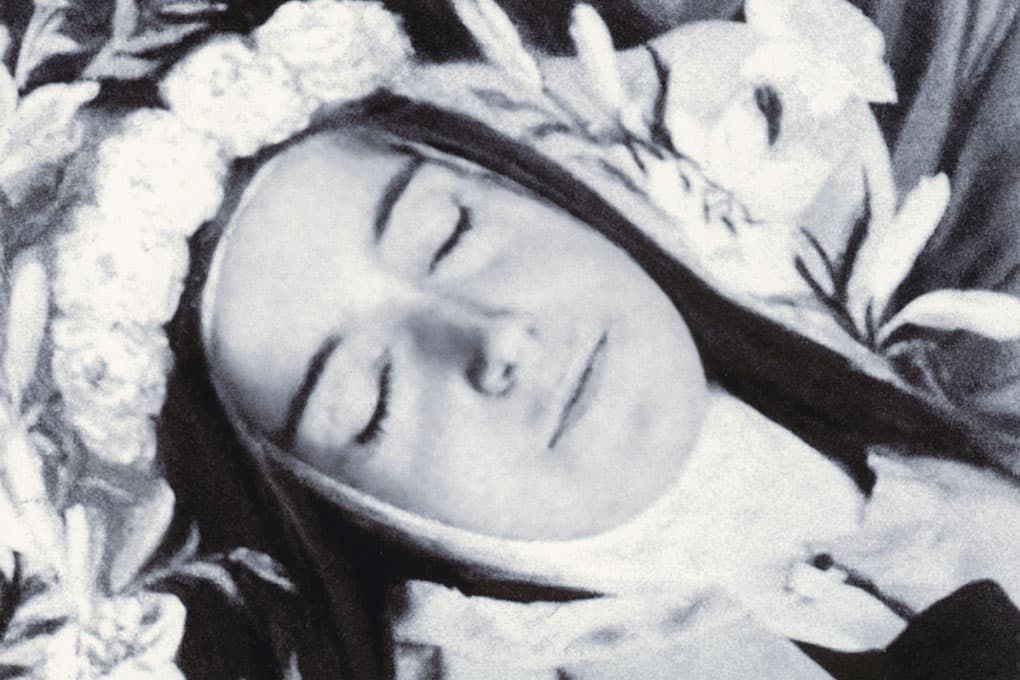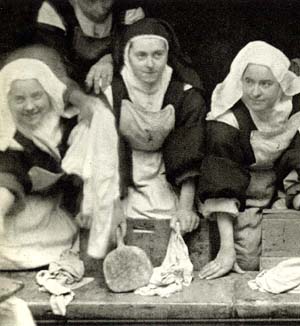127th Anniversary of St. Thérèse
Fidelity to Her Cross
Today we celebrate the 127th anniversary of the Dies Natalis of a most dear secondary patron of our monastery. St. Thérèse died at 7:20 PM on September 30th, 1897. She was 24 years old. Her body radiated joy and innocence after her death, and her sisters were astonished both at how beautiful she was and how young she looked. They said she looked after death like she was thirteen.
Yet this was not the way it seemed before she passed away. Céline Martin, St. Thérèse’s sister, had accompanied their father, St. Louis Martin, to his happy death. At the time, she had been edified by how beautiful a good death could be. The same sister, however, burst out into the night sky weeping after her sister died, crying within herself how ugly death was. The sky itself seemed to reflect this, so full of clouds. And she said to herself, if only I could at least see the sky and the stars! When, all at once, the clouds broke and the stars shone through.
Yet it was not St. Thérèse’s death that lacked beauty. It was commented that it was the most beautiful death that Carmel had ever seen. Her radiant gaze and her last words, “Oh! I love Him….My God, I love You!”, stayed forever with all the sisters who witnessed it. It was, rather, the intensity of her participation in Christ’s Passion. A year earlier, she had quoted to her sister Marie the words of Père Pichon that had stayed with her for a decade: “The martyrs suffered with joy, and the King of Martyrs suffered with sadness.” She may have still been reflecting on this when, on July 4, a few months before she died, she said: “Our Lord died on the Cross in agony, and yet this is the most beautiful death of love. This is the only one that was seen; no one saw that of the Blessed Virgin. To die of love is not to die in transports. I tell you frankly, it seems to me that this is what I am experiencing.”
She herself predicted that her death would not be one of peaceful radiance. One day, three months before her death, when she was peaceful and her face radiant, she told her sisters: “You mustn’t expect to see me like this at the moment of death.”
Her death, indeed, was very different from that peace, right up until the last minute.
She Never Refused God Anything
St. Thérèse’s cousin, Sr. Marie of the Eucharist, asked the Saint a few months before her death if she ever refused God anything. She recalls:
I asked her the other day: “Did you sometimes refuse God anything?” She said: “No, l don’t remember refusing Him anything. Even when I was very little, at the age of three, I began to refuse God nothing He was asking from me.” –Last Conversations
St. Francis de Sales’ favourite prayer was said to be simply: “Yes, Father. Yes, and always yes.” It was this prayer that, whether knowingly or not, St. Thérèse made her own at every moment of her conscious life, and at every moment of her carrying of her own Cross.
“Then Jesus told his disciples, ‘If anyone would come after me, let him deny himself and take up his cross and follow me. For whoever would save his life will lose it, but whoever loses his life for my sake will find it. For what will it profit a man if he gains the whole world and forfeits his soul? Or what shall a man give in return for his soul?” (Mt 16:24-26).
These words of the Lord could have been spoken of St. Thérèse.
I Really Will It
On the day when her beautiful soul would wing its way to God, St. Thérèse testified about herself: “Oh!…it’s the agony, really, without any mixture of consolation.”
The Lord permitted her to feel that this would last forever. It seemed to her that death would never come. “I no longer believe in death for me. . . . I believe only in suffering. . . . Well, so much the better! . . .”
It was that “So much the better” that summarized her donation of her entire self, a gift that would know no refusal.
There was, right at the end, one final test of how complete her willingness to be conformed to Jesus’ Cross was. We quote from Last Conversations, the Yellow Notebook:
She appeared to be at the end of her strength and nevertheless, to our great surprise, she was able to move, to sit up in her bed.
“You see the strength that I have today! No, I’m not going to die! I still have strength for months, perhaps years!”
“And if God willed it,” asked Mother Prioress, “Would you accept it?” She began to answer in her agony:
“It would really have to be . . .”
But checking herself immediately, she said with a tone of sublime resignation, falling back on her pillows:
“I really will it!”
Her “I really will it!” overcoming all the reluctance of nature at that moment constituted a final surrender to merciuful love. She had said a few days before: “No, it isn’t frightful. A little victim of love cannot find frightful what her Spouse sends her through love.” We, however, might be tempted to see it otherwise, and yet her heart was so full of love. “And I am not sorry for delivering myself up to Love,” she said, with insistence: “Oh! no, I’m not sorry; on the contrary!”
An Agony Like Christ’s
Let us listen for a moment to Bishop Guy Gaucher’s description of a particular episode 127 years ago today that illustrates how closely St. Thérèse’s last hours resembled her Divine Bridegroom’s.
Her agony of September 30 would be like that of Jesus, “without any mixture of consolation”.
When about three o’clock, she put out her arms in the form of the cross, leaning on her two sisters, gasping for breath, and trying to find some relief, those around her were forcibly reminded of the Crucified: “For us she was a striking image of Jesus on the Cross. I regarded this coincidence as full of mystery…” When the same witness, Sister Geneviève, was speaking of her sister’s little cries and groaning, she added:
“Those broken words, all bearing the stamp of perfect conformity to God’s will, were heart-breaking to hear. Like Jesus, God seemed to have abandoned her.”
The Consolation of Her Passion
Bishop Gaucher continues:
A person reading the Last Conversations would normally be left with a feeling of extreme sadness. What could be more heart-rending, more disastrous, than the gradual destruction of a young person whose cells are all calling out for life?
Thérèse was spared the “wreck of old age”, but not the slow destruction of the body by illness, with its train of miseries and humiliations. It is true that she did not know the deterioration of her mental faculties. Until her last breath — like Jesus — she remained lucid and mentally alert. In the strict sense, she saw herself die. She was able to make an offering of her death.
And yet that reading radiates peace. Terrible as it was, the death of Thérèse of the Holy Face cannot arouse only sorrow and tears. The reader is aware of a passage, not an annihilation. Dead, she seems to be still living. Or rather, at last living with regard to her universal mission. And so, in the Lisieux Carmel, the first anniversary of her death was, strange to say, an occasion for joy.
For had she not written to Abbé Bellière:
Yes, I am sure that after my entry into life, my dear little Brother’s sorrow will be turned into deepest joy, a joy that no one will be able to take from him. (From The Passion of Thérèse of Lisieux, by Guy Gaucher)
Helping us to bear our Cross
Suffering of this magnitude in imitation of her Lord was St. Thérèse’s vocation, it may not be yours or mine.
Yet she who said of herself that she loved her Cross with a passion also knows how to help us to love our Cross, smaller by measure, no doubt, but no less important to God’s plan of merciful love. Does it seem impossible to love our Cross? She who said yes to the end can assist us.


